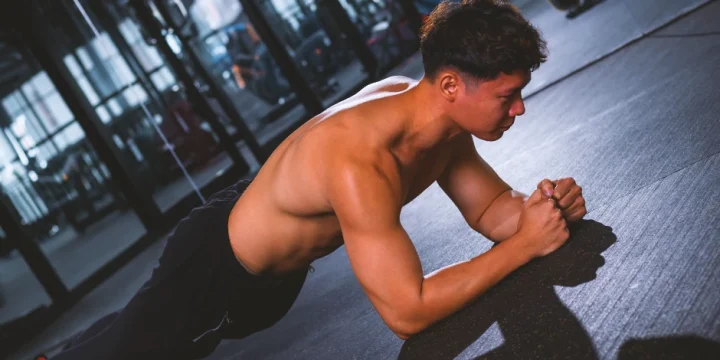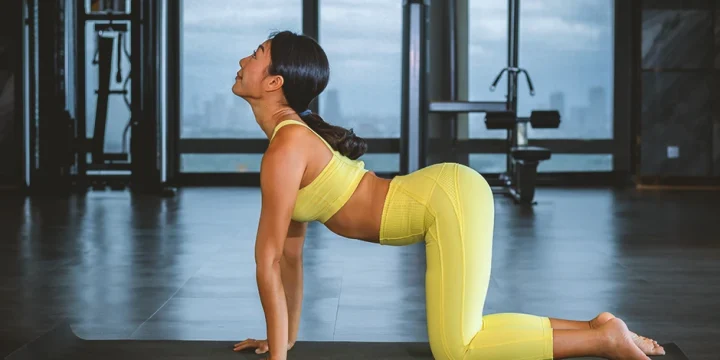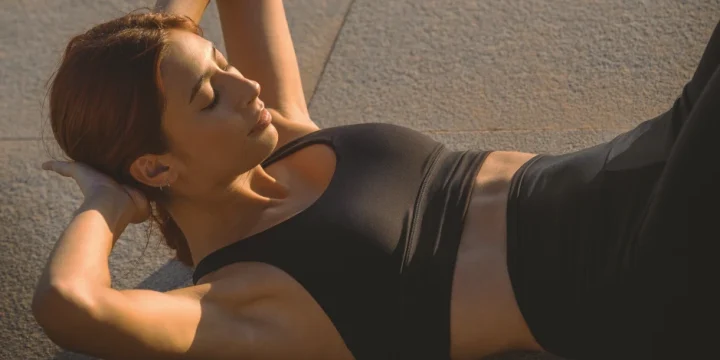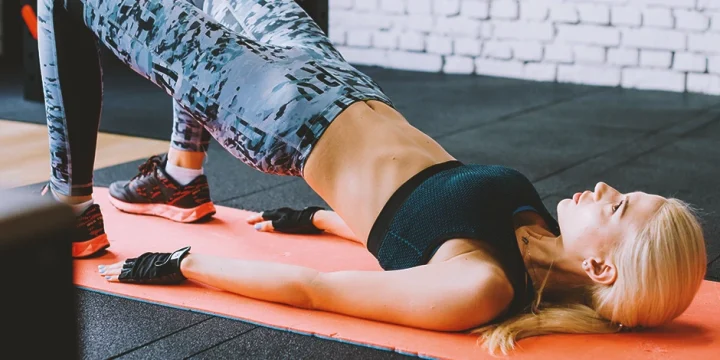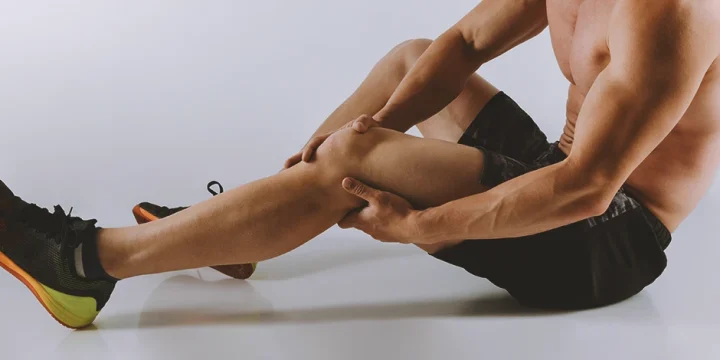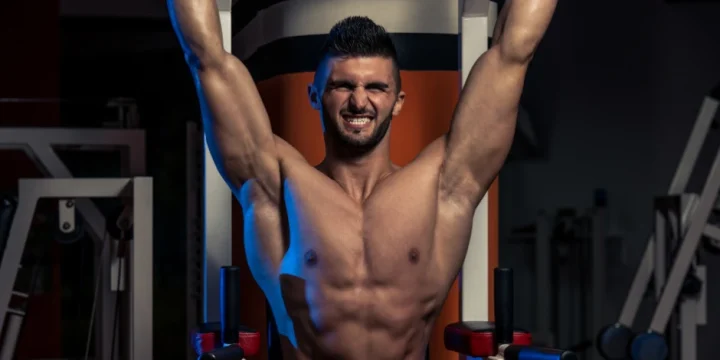Bodyweight workouts are an excellent way to enhance strength, muscle endurance, coordination, and balance, and core bodyweight exercises are no exception.
You will increase your stability, posture, explosiveness, agility, and speed by strengthening your core.
So, what are the best bodyweight exercises to strengthen your core?
As a certified fitness trainer with over eight years of experience, I will provide my expertise on the best bodyweight core exercises you can include in your routine and the benefits of performing these exercises.
Quick Summary
- The best bodyweight core exercises include the plank, side plank, reverse crunch, side plank with crunch, squat with rotation, plank with a march, mountain climbers, bird dogs with knee-elbow touches, bicycle crunch, and plank shoulder taps.
- Core workouts do not require much equipment. The trick is to ensure you choose the most efficient core activities and execute them correctly.
- According to Harvard Health Publishing, a strong core can prevent falls and injuries during sports, improve arm and leg movements, support your posture, and enhance your overall stability.
- To reach the results faster, consider incorporating these workouts into your program with these best post-workout supplements for faster recovery.
The Best Bodyweight Core Exercises

After scrounging through hundreds of my personalized calisthenic workout routines, speaking to various clients, and partnering with a fellow trainer, I've put together a list of 10 highly effective bodyweight core exercises.
1. Plank
The plank is among the greatest core exercises (and a personal favorite of mine) for a strong lower and upper body since it strengthens all your muscles.
The forearm plank is a good place to start for beginners.
Here's how you do it:
- Place your forearms on the ground, elbows below shoulders, and hands parallel to your torso approximately shoulder width.
- Have your legs extended and hip-width apart.
- Maintain a neutral spine. Maintain your hips up, and don't allow them to sink to the floor while you hold.
- Maintain a strong core and compress the feet and glutes at all times.
- Concentrate on maintaining everything tight for the time allocated.
2. Side Plank
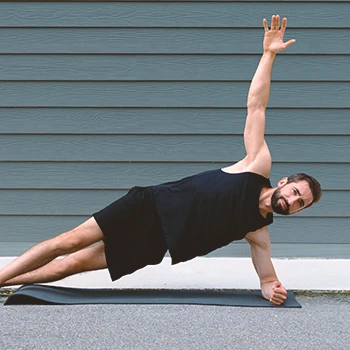
Here's how you perform this exercise:
- Begin on your left side on the floor, resting your left forearm on the ground and the elbow under your shoulder.
- Keep your shoulders and legs in a straight line by pushing up off your elbow.
- Your hips, just the side of the left leg, and the elbow should be above the ground.
- Hold the side plank posture for the desired number of times.
"The side plank tests your balance while using your shoulder and hip muscles to maintain stability. Because it is a unilateral exercise (it exercises only one side of the torso at a time), the side plank may also assist in fixing muscular imbalances."
- Sal Nakhlawi, Certified Functional Strength Coach
3. Reverse Crunch
The reverse crunch is a tough core exercise that primarily targets the rectus abdominis, the abdominal muscle that makes your "six-pack."
Here's how you do it with good form:
- Lie face up on a rug or other soft surface, knees bent at 90°, and the right and left leg flat on the floor before you. Keep your arms close to your sides, palms down.
- Exhale and tighten your abs. Lift yourself off the floor and elevate your thighs to a vertical position. Throughout the action, maintain your knees bent at 90°.
- Tuck your knees toward the face as far as possible without raising your mid-back off the mat. Lift the lower back and hips off the ground.
- Hold briefly, then slowly drop your right and left foot back to the starting position.
- Repeat for the desired number of repetitions.
4. Side Plank With Crunch
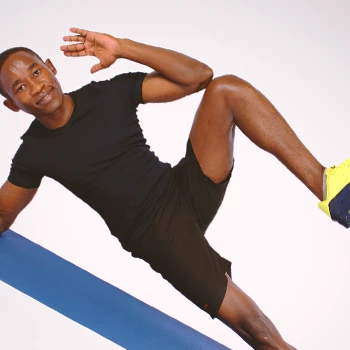
The side plank crunch is an exercise I recommend to my intermediate and elite clients.
By incorporating it into their routines, I've noticed it's a great way to engage those hard-to-reach oblique muscles, offering a more comprehensive core workout than traditional crunches alone.
Here's how to perform them:
- Begin in a side plank position, having your left elbow precisely under your left shoulder, your right and left feet stacked, and your hips lifted. Engage the core.
- Raise your right leg and place the right hand behind the head.
- Crunch the right knee to the right elbow.
- Return to the starting position and repeat.
Read More: Planks vs Crunches: Muscles Worked
5. Squat With Rotation
Here's how to perform this exercise:
- Begin standing with both feet shoulder-width apart and both hands behind the head and elbows out. This is your starting position.
- Lower into a squat position by sending your hips back and knees bent. Maintain a high chest.
- To stand, press through the heels, then twist your body to the right while pulling the right leg to your left elbow.
- Get back to your starting position before performing another squat.
- Stand up and twist your body to the left, pulling your left leg near your right elbow.
- Repeat for the desired number of reps.
6. Plank With March
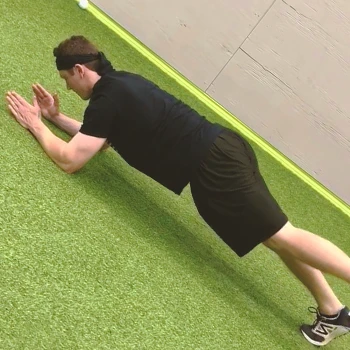
This dynamic variation of the plan will put your core to the test.
To perform this exercise with good form:
- Place your forearms on the ground, elbows below shoulders, and hands parallel to your torso at about shoulder width. You might also have your arms extended instead of your forearms.
- Have your feet hip-width apart.
- Maintain a neutral spine. Keep the hips up, and don't allow them to sink to the floor while you hold.
- Lift the leg off the ground, then return to the starting position; lift the right leg off the ground and return it to the starting point. Continue alternating in this manner for the allocated period.
- Maintain a strong core and compress your glutes and legs at all times. Concentrate on maintaining everything tight.
7. Mountain Climbers
How to perform mountain climbers with good form:
- Put both hands on the floor in a regular plank position. Ensure your weight is equally distributed between the hands and toes. Arms should be shoulder-width apart and exactly beneath the holders. Your abs must be engaged, your back flat, the vertebrae neutral, and the back of the head or neck should parallel your back.
- Bring the left knee as close to your chest as possible. Bring the right knee to the chest as you return to the starting position.
- Alternate for the duration or amount of reps required.
8. Bird Dogs With Knee-Elbow Touches
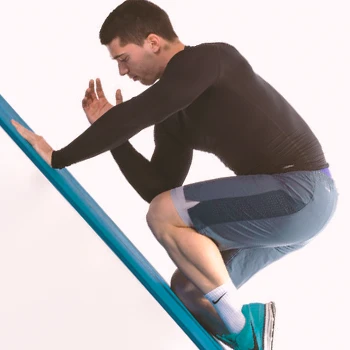
What I love about this exercise is that it will test and work your core stability, strength, and spinal alignment.
To perform it:
- Start on all fours with your knees and hand on the floor. Arms should be under your shoulders, and knees should be under your hips.
- Activate the core and extend the right arm in front of you, followed by the left leg straight back, parallel to the floor. Hold for a while before moving your right arm and left knee to the center and attempting to make contact. Slowly squeeze and move.
- Resume the starting position, extend the left arm before you, and straighten your right leg. Hold for a while before moving your left arm and right knee to the center and attempting to make contact. Slowly squeeze and move.
- Revert to the starting position and repeat on the opposite side.
- Keep alternating sides for the duration or number of reps specified.
9. Bicycle Crunch
The introduction of bicycle crunches into my routine has transformed my approach to core strength, especially with their ability to simultaneously work multiple muscle groups for a comprehensive abdominal workout.
Here's how you do them:
- Lie down on your back.
- Place both hands behind your head, tense your abs, pull your knee to the chest, and raise your shoulders off the surface while rotating the right elbow to the left knee.
- Touch the elbow to the knee, then return to the starting position.
- As you lower yourself, switch sides — left elbow to right knee.
- Alternate for the duration of the set repetitions or time.
Learn More: Do Crunches Reduce Belly Fat
10. Plank Shoulder Taps
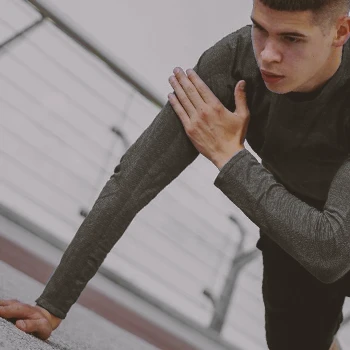
Plank shoulder taps are a plank variant with an extra compound action.
Here's how you do them:
- Begin in a plank posture, with wrists beneath shoulders and feet hip-width apart.
- Touch the right shoulder with your left hand, then return it to the starting position.
- Contact the left shoulder with the right hand and return it to the starting.
- Continue alternating your hands until the set is completed.
"With the addition of the shoulder tap, you successfully activate the obliques while increasing the strain on the smaller muscles (stabilizers) to prevent your body from twisting excessively."
- Teddy Savage, Certified Personal Trainer
What Are the Core Muscles?

The core muscles are a group of muscles in your midsection that are essential for stabilizing your body, supporting your spine, and aiding in overall movement.
According to Harvard Health Publishing, a strong core can prevent falls and injuries during sports, improve arm and leg movements, support your posture, and enhance your overall stability [1].
The following is a comprehensive list of the core muscle groups:
- Rectus abdominis, called "abdominal muscles" or "abs: The rectus abdominis is an abdomen muscle that connects your rib cage to the pelvis [2].
- Internal obliques: These are found beneath the rectus abdominis and are classified as oblique. They run in the opposite direction as the external obliques. They provide for spinal flexion and stability and trunk rotation to the same side of the body [3].
- External obliques: These muscles are found on both sides and in front of the abdomen. They help to maintain spinal stability and allow you to bend and flex your body to the side [4].
- Transverse abdominis: This muscle is placed beneath the obliques. They are the deepest abdominal muscles that wrap around the spine for protection [5].
- The quadratus lumborum: It is the deepest posterior core muscle, located opposite the transverse abdominis. This muscle group supports, extends, and rotates the spine [6].
- Erector spinae: This is a large muscle group near the rear of your core. It extends from your neck to the lower part of your back [7]. You use your erector spinae whenever you bend or twist.
- Hip flexors: A set of muscles in front of your pelvis and upper thigh. They encompass the psoas, rectus femoris, sartorius, and pectineus muscles. Your hip flexors elevate your knee and move it closer to your torso, which is called flexion, thus the term flexors [8].
- Other core muscles include the multifidus (placed behind the erector spinae along the spinal column), the pelvic floor muscles, hip adductors and abductors, and the glutes.
Learn More: Best At-Home Core Workout
Benefits of Core Bodyweight Exercises

Training your core has numerous advantages.
In my own fitness journey, I've come to realize the immense benefits that core strength training offers, impacting not just my workouts but my everyday activities as well.
Here are some of the key benefits of developing a strong core through bodyweight exercises.
1. Injury Prevention
Core training is not only beneficial for minimizing the chance of spinal injuries, but it is also helpful for the other joints in the body since inadequate core strength leads to poor balance, which leads to strain on the knees, ankles, and hips.
2. Improved Stability
A strong core helps create optimum weight distribution and the absorption and transmission of forces, keeping you stable during complex movements.
3. Enhanced Athletic Performance
Core bodyweight exercises improve strength, explosiveness, power, balance, speed, coordination, and agility. After all, your core transfers energy and power to and from your arms and legs.
4. Increased Rotational and Anti-rotational Strength
A strong core generates rotational force, enabling you to twist, spin, swing, accelerate, decelerate, and move in different directions with greater power and efficiency.
Furthermore, you can accomplish these activities safely because you have anti-rotation power, which helps you avoid injuries, stand strong, and maintain balance. Rotational and anti-rotational power go hand in hand.
5. Better Posture
A strong and stable core may improve your posture when the body is both stationary and moving.
6. Carry-over Effect To Other Lifts
A stronger core contributes to a stronger military press, squat, bench press, deadlift, etc. Core training can help you gain muscle in other body parts and break past plateaus in your major lifts.
7. Alleviation of Lower Back Pain
According to a study I found in the National Library of Medicine, core stability exercises are an excellent technique to alleviate persistent low back pain [9].
FAQs
Are Bodyweight Core Exercises Effective?
Yes, bodyweight core exercises are effective. Bodyweight ab exercises increase core stability, strength, posture, and athletic performance.
Can You Strengthen Your Core Without Weights?
Yes, you can strengthen your core without weights. You can perform exercises such as crunches, bird dogs, back extensions, front and side planks, and skydivers that enhance and build your core muscles.
Is It OK To Train Core Everyday?
No. It's not okay to train your core every day. Your abs, like any other muscle, require rest. They have to recuperate and rebuild stronger than before.
References:
- https://www.health.harvard.edu/healthbeat/the-real-world-benefits-of-strengthening-your-core
- https://www.sciencedirect.com/topics/immunology-and-microbiology/rectus-abdominis-muscle
- https://pubmed.ncbi.nlm.nih.gov/2935630/
- https://pubmed.ncbi.nlm.nih.gov/10409811/
- https://pubmed.ncbi.nlm.nih.gov/2140344/
- https://www.ncbi.nlm.nih.gov/books/NBK535407/
- https://www.ncbi.nlm.nih.gov/books/NBK537074/
- https://pubmed.ncbi.nlm.nih.gov/9118976/
- https://www.ncbi.nlm.nih.gov/pmc/articles/PMC5648929/
About The Author
You May Also Like
